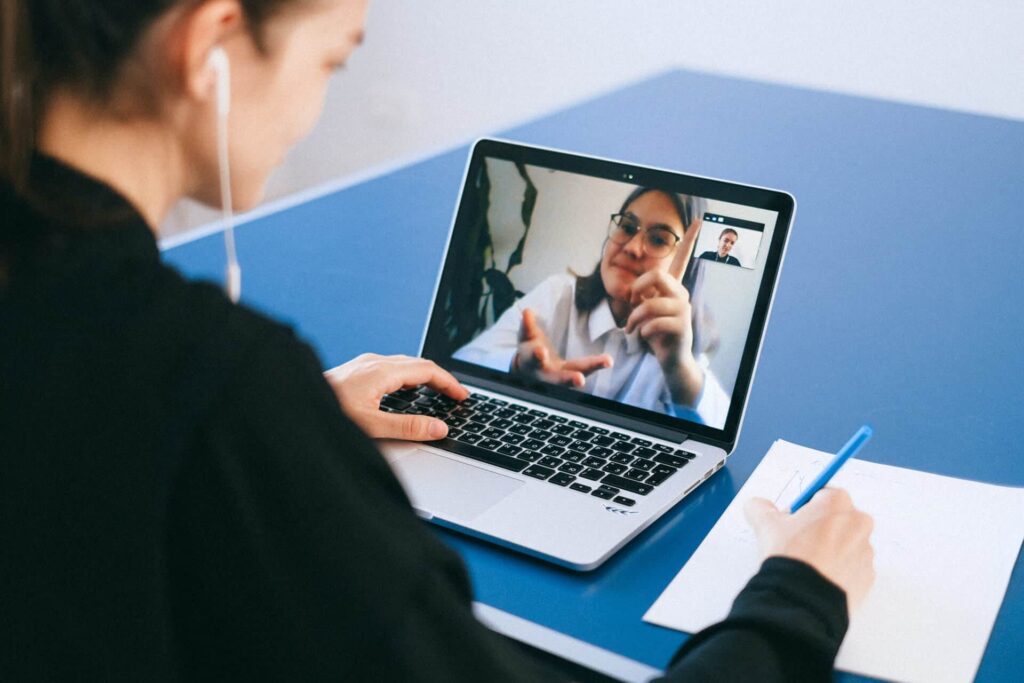The hybrid experience is the ‘new normal’ in the office. There is now almost universal consensus that the future of work will be hybrid.
While some companies and industries might have been flirting with hybrid working before the pandemic, it has been definitively pushed to the mainstream of working today. Now that facility managers (FMs) have both the time and the tools necessary to maximize the hybrid experience, employees can expect a better employee experience and work-life balance. And companies can expect to save money and stay more flexible.
In this article, we explore the hybrid experience as it relates to working. We also touch on powerful tools and strategies to make it better for everyone, reviewing all our essential hybrid content in one place.
What is a hybrid workplace?
A hybrid workplace is one that combines remote work with onsite work.
This will look a little different for each company. For example, some companies will have employees working in-office and remotely in shifts. Others, like those following agile working principles, will let their employees choose when and how often they want to work remotely.
A hybrid workplace presents many benefits, ranging from cost savings to improved productivity. That said, these benefits will only be realized when FMs and organizations carefully choose the right way to implement it.
The 4 hybrid models of the future workplace
We are currently seeing four hybrid workplace models emerging. These range from companies that barely allow any flexibility, to those that embrace hybrid work completely.
There are no right or wrong models, only ones that are better for an organization’s company culture and working demands. A company’s goals and budget are often the driving force in how aggressively and quickly they adopt hybrid work. This also influences which hybrid workplace model they choose.

What is a hybrid experience?
A hybrid experience is one in which some people are accessing a space or an event in person, while others do so virtually.
For live events, this often means a live stream to a virtual audience in real time. Hopefully, this is presented seamlessly enough that the virtual experience is just as exciting as it is for the in-person audience.
In the workplace, the hybrid experience is one in which the ‘office’ is accessible by both in-office workers and those working elsewhere—maybe from their kitchen table, an airport, or a coffee shop across the street.
It’s not quite a virtual reality office. However, companies can benefit from smart technology like IoT sensors and artificial intelligence to enhance the hybrid experience and create the next best thing.
When remote workers have on-demand technology and good digital workplace solutions, they can really feel like they’re at the office, even when they’re not. For example, when FMs know how to run effective hybrid meetings, they can create a live experience for virtual attendees that is just as good as it is for in-person attendees.
Assuming FMs plan for equal participation and give employees the tools they need, they can create hybrid events and a hybrid workplace experience that actually enhances innovation and collaboration, instead of draining it.
In other words, the hybrid experience is one in which all employees feel connected and able to contribute and work diligently. They should feel like they’re ‘in the office’—no matter where they are.
How hybrid workplace technology and Industry 4.0 are changing the future of work
Ultimately, the hybrid experience is about blending hybrid workplace technology with good office design and workplace policies.
Industry 4.0, also called the fourth industrial revolution, focuses on interconnectivity, driven by elements like the Internet of Things (IoT), smart buildings, and AI-driven data. When FMs combine Industry 4.0 with modern workplace technology, they can enhance both connectivity and employee experience. This, in turn, can lead to a better hybrid work experience.
The hybrid workplace is here to stay. How can FMs plan for it?
FMs have to plan the hybrid workplace carefully if they want to make a better hybrid working experience. This includes offering tools for those using the office—like good desk booking software—and tools for those working from anywhere—like a mobile-friendly way to connect with the office.
FMs should also plan for better information security for the hybrid workplace. This can include best practices like secure passwords and encrypted backups. They should also check-in with the existing security in their building automation system, to see if an expert should upgrade it.

What are the benefits of a hybrid experience?
A hybrid experience benefits every worker, whether they’re working remotely or not. When people can do remote work and in-office work concurrently and in harmony, every team member can thrive.
Traditionally, employees worked side-by-side, or at least cubicle-by-cubicle. When FMs bring in tools and policies that recreate this back-and-forth, they can create a hybrid experience that lets everyone do their best work.
Hybrid model pros and cons in the post-pandemic workplace
FMS need to be aware of hybrid work model pros and cons when planning the hybrid experience.
Yes, most organizations were pushed into hybrid and remote work thanks to COVID-19. But this work model persists because companies were pleasantly surprised by its benefits.
Namely, hybrid workplaces are often more productive, flexible, and agile, all crucial qualities in today’s competitive market. Hybrid offices can usually make better use of their space as well. This can lead to cost savings from real estate and related expenses. This reduction in space can also help lower a company’s carbon footprint.
Employees are also now demanding hybrid work, in part because of how it can improve employee experience. In this way, offering hybrid work can also give companies a leg-up when trying to keep and/or attract top talent.
That said, there are also drawbacks to hybrid working. Communication and collaboration can be trickier in hybrid offices, which can lead to divisions between employees and other struggles. Hybrid working can also be difficult to implement without the right tools and strategy.
That’s why FMs will need to ensure they are maximizing the hybrid experience, to reduce any potential drawbacks and ramp up any benefits.

Maximizing the hybrid experience
Hybrid working presents a level of complexity that just didn’t exist in the 9-5, workers-in-cubicles model. It may offer many benefits to employees and employers, but only when FMs and companies manage it properly.
That’s why FMs need the right initiatives and messaging to ensure that everyone understands how to make hybrid work best in their unique organization. The easier the virtual components of the office and the more all employees are able to buy-in to them, the better the hybrid experience will be.
The hybrid office: How can workplace leaders embrace the future of work?
Since the pandemic, we’ve seen smart business leaders step up to the challenge of creating a better hybrid office, taking both employee safety and their preferred working styles into consideration. They have also rolled out hybrid working in a way that lets employees feel supported.
For example, giving employees greater clarity around when they should be coming into the office, along with more visibility as to who is using the office, can be incredibly powerful.
“Companies need to remove barriers to adopting the hybrid model,” says OfficeSpace VP of Product and Strategy, Luke Anderson. “It needs to be easy for employees to find what they need, book desks, and feel comfortable and productive.”
Hybrid workplace: best practices for a data-driven office
FMs should follow hybrid workplace best practices if they want employees to get the most from the hybrid experience.
These include offering flexible seating, supporting different employee working styles, and collecting real-time data on who uses the office and how they use it.
Hybrid workforce: How to give employees what they want
When determining best practices, FMs should focus on their hybrid workforce, who are increasingly demanding more flexibility and more health measures at work.
We know from an OfficeSpace Harris Poll that 43% of workers would consider leaving their job if they were forced to work at the office full time. In other words, almost half of workers are demanding some form of hybrid work.
To create a successful hybrid experience for these employees requires a concerted effort from FMs to provide the best possible tools and policies. This is often best accomplished by collaborating with both HR and IT teams.
Hybrid working tools: top 9 hybrid tools for flexibility
Good hybrid working tools for an improved hybrid experience are those that foster greater productivity and flexibility.
Zoom, Microsoft Teams, and Slack often make the top of this list, for good reason. When used properly, they can dramatically improve communication and collaboration. Companies can also use Google Docs to enhance hybrid teamwork.
FMs will also need to source software that allows for easy room and desk booking, whether that will include hoteling, hot desking, and/or any other flexible seating arrangement.
And no hybrid office can truly capitalize on its potential without analytics software that gives a good picture of how people are using space, how employees are adapting to hybrid work, and where improvements can be made.
Hybrid workplace models
OfficeSpace has worked to create even better workplace management software to meet the demands of hybrid work and create a better hybrid experience.
In 2021, we launched a range of powerful new workplace management tools to help workplace teams respond quickly, reopen safely, and create engaging hybrid workplaces and better hybrid experiences.
In this way, OfficeSpace is helping to future-proof its clients, offering:
- Unmatched room booking and desk booking experiences, including multi-day and recurring bookings
- Fully customizable and time-saving office neighborhoods with team-managed seating
- Improved visibility, so that workers know who’s booked a desk and who’ll be in the office on any given date; this is especially critical for hybrid workers
- Automated badge access for employees who pass daily health checks, helping to maintain compliance with ever-changing health regulations
- Easy request management and drag-and-drop move management, including stack plans and scenario planning to make it easy to test out ideas before implementing them
- Reporting and analytics that can improve space utilization and reduce corporate real estate costs.
Just as critical, all of these features are available on a mobile app. They can also be available through Microsoft Teams and Slack integrations along with many other systems.
These features are perfect to accommodate workers’ needs today, while also anticipating what those needs will be in the future.
This is done in part by working closely with clients to understand the issues they’re facing on the ground.
“OfficeSpace’s support team is extremely responsive,” says Jason Saham, Director of Executive Operations for Malwarebytes. “They listen attentively to our needs and I’ve seen our requests translate into new products and features many times.”

The hybrid workplace and employee experience: choice matters
Ultimately, OfficeSpace supports both the hybrid workplace and the employee experience, at the same time.
In our future of work, these two concepts are intricately linked. Not surprisingly, when the hybrid workplace is designed with employee experience in mind, both improve. FMs should think of their employees as their customers and work to create a better customer experience for them. When they do this, everyone wins.
In the past year, OfficeSpace has seen its monthly users increase by more than 200%, along with an 800% increase in employees booking desks. Employees are also using Safeguard ten times more. In other words, we’ve seen a dramatic increase in employees accessing tools to help them work better and safer.
Clearly, there is a desire for better workplace experiences and a better managed hybrid experience.
The hybrid experience is a human experience
FMS should consider the human experience when designing and implementing hybrid work. At the end of the day, we’re all people, not robots. We all want a workplace that treats us as such.
So how can FMs make a hybrid experience that helps everyone feel supported and excited to work? The answer is a hybrid workplace strategy. A strategy that uses analytics and powerful tools to enhance flexible working and the employee experience.
OfficeSpace is a flexible software solution to power the hybrid experience. Reach out for a free demo.
Photos: artiemedvedev, Anna Shvets, Darlene Alderson, Yan Krukov, Artem Podrez




